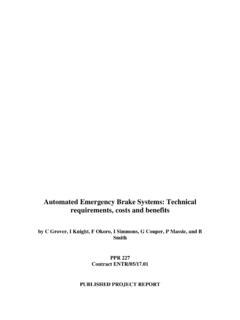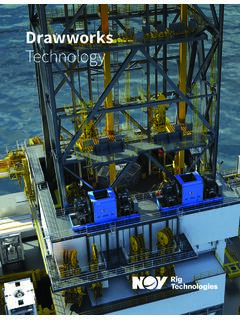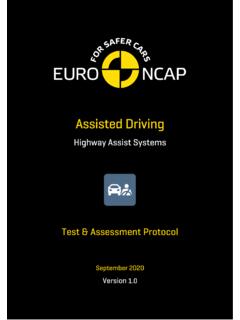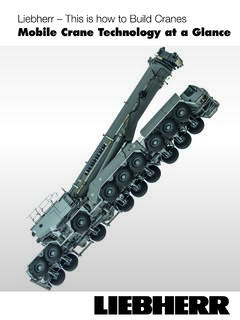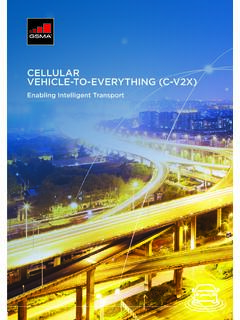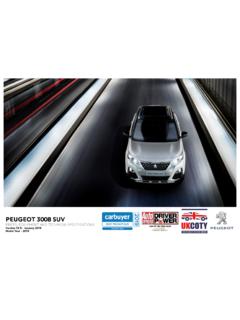Transcription of Automotive ADAS Systems - STMicroelectronics
1 Automotive ADAS SystemsOverall Automotive ADAS SystemTable of Contents ADAS overview ADAS Vehicle Architectures ADAS Technologies/Sensors Vision(Cameras) System LiDAR System Radar System GNSS/IMU System V2X System Sensor Fusion Example2ST ConfidentialAutomotive ADAS SystemsADAS OverviewOverview of ADAS Technologies4 Power Supply/ManagementTargets ADAS Sensors -Needed for Perception5 LIDARR adarCamerasGNSS antennaCentral ComputerUltra-SonicsWheel OdometryThe 5 Levels of Vehicle Automation62 PartialAutomation(Level 2)Driver monitors system at all times4 HighAutomation(Level 4)Driver is not required for specific use casesLearning to Drive Systems Networking Sensor Fusion Distance Measurement Traffic Sign Recognition Lane Reconstruction Free-path Definition Precise Positioning Real-time Mapping Driving Rules Implementation Critical Arbitration Adding Senses Accelerometers and Gyro Steering Wheel Angle Ultrasonic sensors Front Radar Sensor Blind Spot sensor Rear View Cameras Front View Cameras Surround View Cameras0No Automation (Level 0)Driver in control5 Full Automation (Level 5)No DriverRequired1 Driver Assistance(Level 1)Driver in control3 ConditionalAutomation(Level 3)Driver needed to be able to resume controlLevels 0-2 Human driver monitors the driving environmentLevels 3-5 automated driving system monitors the driving environmentSource.
2 SAEstandard J3016 Sensor Fusion is Key to Autonomous7 Source: Woodside Capital Partners (WCP), Beyond the Headlights: ADAS and Autonomous Sensing , September 2016 Automotive ADAS SystemsADAS Vehicle ArchitecturesDistributed vs Centralized Processing Distributed Interfaces ETH, SPI, I2C, CAN, CAN-FD RADAR, Ultrasonic, V2X, IMU, Wheel Odomerty, GNSS MIPI(CSI-2), GMSL(Maxim), FPD-Link(TI), PCIe, HDBaseT(Valens) Video Cameras? Lidar?9 UltrasonicLidarRadarCameraV2 XAcceleration & Rotation , vSpeed GNSSV ehicle StateNLOSLOSP rocessorProcessorProcessorProcessorProce ssorProcessorProcessorProcessorSensor Fusion, Motion Planning, and Driver warningsIntelligent Edge ProcessingVehicle Dynamics and ControlInfotainment & ClusterMCU /MPU /DSPRFS ensorsThink!SenseACTETH / SPI / CAN / CAN-FD Breaking Steering Accelerating.
3 Object dataLate Sensor FusionDistributed Processing with Object Level FusionCentralized Processing with Raw Data FusionLOS: Line-of-SightNLOS: Non-Line-of-Sight Centralized Interfaces ETH, SPI, I2C, CAN, CAN-FD V2X, IMU, Wheel Odomerty, GNSS MIPI(CSI-2), GMSL(Maxim), FPD-Link(TI), PCIe, HDBaseT(Valens) Radar, Ultrasonic Cameras Lidar?UltrasonicLidarRadarCameraV2 XAcceleration & Rotation , vSpeed GNSSV ehicle StateNLOSLOSP rocessorProcessorProcessorProcessorSenso r Fusion, Motion Planning, and Driver warningsRaw Data Capture (I/Q)Vehicle Dynamics and ControlInfotainment & ClusterMCU /MPU /DSPRFS ensorsThink!SenseACTETH / SPI / CAN / CAN-FD Breaking Steering Accelerating ..Raw DataSensor Hybrid FusionNo ProcessingEarly Data from SensorsDistributed vs Centralized Processing 10 Source: 2018 IHS Markit Autonomous Driving-The Changes to come Source: ADI What are the Data rates requirements for each sensor?
4 Centralized ( SERDES?) vs Distributed ( ETH?) Example: 4-5 Corner Radars are utilized in high end/premium ADAS SystemsVision (Cameras) SystemCamera Essential for correctly perceiving environment Richest source of raw data about the scene -only sensor that can reflect the true complexity of the scene. The lowest cost sensor as of today Comparison metrics: Resolution Field of view (FOV) Dynamic range Trade-off between resolution and FOV?12 Camera-Stereo Enables depth estimation from image data13 Left and right imagesFind a point in 3D by triangulation!Source: SanjaFidler, CSC420: Intro to Image UnderstandingAll points on projective line to P map to pOne cameraAdd a second cameraThe Next Phase for Vision Technology From sensing to comprehensive perception Machine learning used already for object sensing Autonomous driving needs Path planning based on holistic cues Dynamic following of the drivable area Deep learning is now being applied14150 50 30 123 Machine Vision.
5 ST & Mobileye15 Product Detection of driving lanes Recognition of traffic signs Detection of pedestrians and cyclists Seeing obstacles how the human eye sees them Adapting cruise speed emergency braking when car ahead slows suddenlyEyeQ3 3rdGeneration vision processorProduct Detection of more objects, more precisely More features required for automated driving Free-space Estimation, Road Profile Reconstruction Monitoring of environmental elements (fog, ice, rain) and their safety impact Detailed understanding of the road conditions allowing automatic suspension and steering adjustment Highly automated vehiclesEyeQ4 4thGeneration enablesPartnershipProductEyeQ5 TMThe Road to Full Autonomous Driving: Mobileye and ST to Develop EyeQ 5 SoCtargeting Sensor Fusion Central Computer for Autonomous VehiclesEyeQ5 Automotive ADAS SystemsLiDAR SystemLiDAR Technology Overview17distancePhotonMeasured distance=Speed of light xPhoton travel time /2 EmitterReceiver LiDAR (light detecting and ranging, or light radar ) sensors send one or more laser beams at a high frequency and use the Time-of-Flight principle to measure distances.
6 LiDAR capture a high-resolution point cloud of the environment. Can be used for object detection, as well as mapping an environment Detailed 3D scene geometry from LIDAR point cloud LiDAR uses the same principal as ToFsensor, but at much longer distances, minimum 75M for near field and 150-200M for far field .Targets 2 sec2-10 nsecLiDAR Techniques There are multiple techniques currently under evaluation for LiDAR including rotating assembly, rotating mirrors, Flash (single Txsource, array Rx), scanning MEMS micro-mirrors, optical phased array. From a transmitter/receiver (Tx/Rx) perspective the following technologies need to be developed or industrialized for Automotive . MEMS Scanning Micro-mirror technologies SPAD (Single Photon Avalanche Detectors) -Rx 3D SPAD -Rx Smart GaN(Gallium nitride) Comparison metrics: Number of beams: 8,16, 32, and 64 being common sizes Points per second: The faster, the more detailed the 3D point cloud can be Rotation rate: higher rate, the faster the 3D point clouds are updated Detection Range: dictated by the power output of the light source Field of view: angular extent visible to the LIDAR sensor18 Upcoming: Solid state LIDAR!
7 LiDAR Summary Autonomous vehicles have been around for quite some time but only now the technologies are available for practical implementations No single sensor solution exists to cover all aspects range, accuracy, environmental conditions, color discrimination, latency etc. Multi-sensor fusion and integration will be a must Each technology attempts to solve the overall problem while having multiple limitations Many LiDAR solutions (technologies) are available or being proposed with no clear winners Market is still in very early stage of development and experimentation When and which technology or system will be widely adopted and mass production starts is still unknown19 Automotive ADAS SystemsRadar SystemsRADAR Technology Overview21 RADAR (RAdioDetection and Ranging) is one necessary sensor for ADAS (Advanced Driver Assistance System) Systems for the detection and location of objects in the presence of interference; , noise, clutter, and jamming.
8 Robust Object Detection and Relative Speed Estimation Transmit a radio signal toward a target, Receive the reflected signal energy from target The radio signal can the form of Pulsed or Continuous Wave Works in poor visibility like fog and precipitation! Automotive radars utilize Linear FM signal, Frequency Modulated Continuous Wave (FMCW) FM results in a shift between the TX and RX signals that allows for the determination of time delay, Range and (R)=Speed of propagation in medium (c in air)xSignal travel time /2 Targets GtArRADAR Techniques22 Source: Strategy Analytics Lunch & Learn the Market Session European Microwave Week 2013 Comparison metrics: Range Field of view Position and speed accuracy Configurations: Wide-FOV: Short Range Narrow-FOV: Long RangeAutomotive Radar Vs. Automation Levels23< 2014 Level 1 Driver Assistance2016 Level 2 Partial Automation2018 Level 3 Conditional Automation2019 / 2020 Level 4 High Automation> 2028 Level 5 Full AutomationObject detectionObject detectionHigh resolutiontarget separation3D detection360 object recognition2x SRR2x SRR1x LRR4x SRR1x LRR4x SRR-MRR1x LRR2x USRR4x SRR-MRR2x LRRA pplicationsBSD, LCAA pplicationsBSD, RCW, LCAACC, AEBA pplicationsBSD, RCW, LCAFCW, RCTAACC, AEBA pplicationsBSD, LCA, RCTAAEB pedestrianACC, AEBA pplicationsAVP, PABSD, LCA, RCTAAEB pedestrianACC.
9 AEBBSD -Blind Sport DetectionLCA -Lane Change AssistRCW -Rear Collision WarningACC -Adaptive Cruise ControlAEB -Automatic emergency BreakingFCW -Forward Collision WarningRCTA -Rear Cross Traffic AlertAVP - automated Valet ParkingPA -Parking AssistUSRR -Ultra Short Range RadarSRR -Short Range RadarMRR -Medium Range RadarLRR -Long Range RadarSource: Rodhe& Schwarz - Automotive radar technology, market and test requirements, White paper Oct 2018 (Salvo S. presentation) Automotive ADAS SystemsGNSS/IMU SystemGNSS/IMU Positioning Global Navigation Satellite Systems and Inertial Measurement Units Direct measure of vehicle states Positioning, velocity, and time (GNSS) Varying accuracies: Real-time Kinematic (RTK-short base line), Precise Point Positioning (PPP), Differential Global Positioning System (DGPS), Satellite-based augmentation system (SBAS-Ionosphericdelay correction) Angular rotation rate (IMU) Acceleration (IMU) Heading (IMU, GPS)25 GNSS/IMUP recise Positioning to enable < 30cm precision Lane detection Positioning data for V2X sharing Collision avoidance Autonomous parking Autonomous driving eCallaccident locationGNSS/IMU PositioningMore Precision Enables More Safety Features26 Precise Positioning.
10 Towards Autonomous Driving0 Multi BandL1, L2 and L5, GPS <30cmGPSGLONASSBeiDouGalileoQZSSSBASC arrier PhaseRTKPPPS ensor fusionHigher integrity requirements across safety-critical applications Semi-and Autonomous driving safety-related applications requirements increase Higher safety levels Added redundancy More Robustness & integrity Security Teseo APP(ASIL Precise Positioning) GNSS receiver, new sensor based on ISO26262 concept with unique Absolute and Safepositioning information complementing relativepositioning other sensor inputs( LIDAR, RADAR, etc.)ST s GNSS Receiver Familyfor ADAS and ADPrecise GNSS is a Critical ADAS Sensor 27 Courtesy of Hexagon PIBad SolutionDeclared GoodHAZARD!Bad SolutionDetectedSAFE FAILUREGood SolutionConfirmedSAFE OPERATIONHPL Horizontal Protection LevelVPL Vertical Protection LevelGNSS Accuracy in Automotive Environment (using PPP Precise Point Positioning)Precise GNSS is a Critical ADAS Sensor28 Single Frequency ( L1) multi-constellation/code-phase(1msec modulation signal)Multi Frequency ( L1, L2) multi-constellation/carrier-phaseSWPE: Software Positioning EngineAPP.










